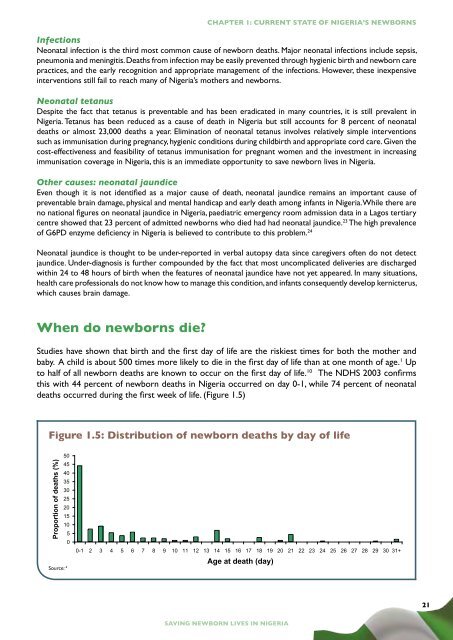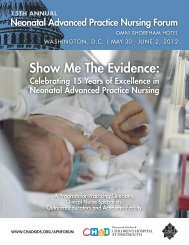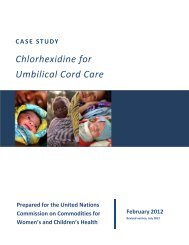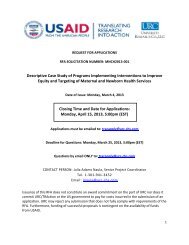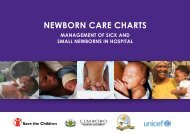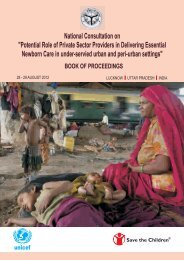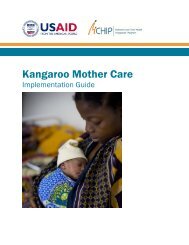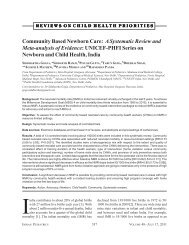CHAPTER 1: CURRENT STATE OF NIGERIA’S NEWBORNSWhy do Nigerian newborns die?Facility-based data alone over-represents complicated obstetric cases and so deaths due to severe pretermbirth and asphyxiated newborns tend to be a higher proportion than for population-based data. Infections suchas neonatal sepsis or tetanus are missed in facility-based data because these deaths often occur at home, afterdischarge from the hospital or health centre and/or among lower income families with inadequate access to healthfacilities. For this reason, the data used here are estimates for the year 2006 based on multinomial regressionused to model the proportion of deaths due to each cause as developed by WHO and UNICEF with the Child10, 11, 16Health Epidemiology Reference Group.According to the best estimates, the major causesof newborn death in Nigeria are birth asphyxia(26 percent), complications of preterm birth (25percent), severe infections (22 percent). Neonataltetanus still accounts for 8 percent of neonataldeaths. (Figure 1.4)Birth asphyxiaBirth asphyxia or intrapartum-related neonataldeaths remain a major cause of newborn deathand disability in Nigeria. National estimatesreport asphyxia as the most common cause ofneonatal mortality, constituting more than onequarter of all cases. For each asphyxia-relatednewborn death, many more babies are left withpermanent disabilities. A study from a tertiarycentre in Nigeria found a neonatal encephalopathyFigure 1.4: Estimated causes ofnewborn death in Nigeria11, 16Source:Preterm,25%Other, 8%Congenital,7%Diarrhoea,4% Tetanus,8%Asphyxia,27%Infection,22%incidence of 26.5 per 1,000 live births, with nearly half of the cases categorised as severe. 17 Almost all babies whosurvive severe neonatal encephalopathy are expected to have impairment. 18Underlying factors that contribute to birth asphyxia include the classical list of the “three delays” that also applyto maternal deaths and stillbirths: 191. Delay in recognition of complications and especially in seeking care for obstructed labour,2. Delay in accessing secondary and tertiary centres for appropriate care: and3. Delay in receiving timely appropriate care once at the facility, due to inadequate numbers of staff, lack ofequipment and supplies, inadequate preparedness to respond to obstetric emergencies, or lack of skillsor equipment for resuscitation. 20Only 44 per cent of deliveries are attended by skilled birth attendants and most Nigerian health facilities lackpartographs for monitoring the progress of labour. 21Preterm birthPreterm birth is a major direct cause of neonatal death accounting for an estimated 25% of neonatal deaths inNigeria. Up to 80 percent of neonatal deaths are among preterm babies as this is a major risk factor for othercauses of death, especially infections. 11 Nationally, it is estimated that 14 percent of Nigerian babies are bornwith low birth weight (LBW), weighing less than 2,500 grams, 1 and in Nigeria most LBW babies are preterm. TheNDHS 2003 reports that the NMR for births categorised as small or very small was 67 per 1,000 live births,compared to 42 among average or larger babies. 4Although it is difficult to prevent preterm births, major reductions in neonatal deaths are achievable by targetingpreterm babies and improving simple care. High technology care is not always necessary. A number of simple,evidence-based interventions such as adequate hygiene, thermal care and breastfeeding can be practiced at home.Kangaroo Mother Care (KMC), which involves ongoing skin-to-skin contact between mother and baby, infectionprevention and breastfeeding, has been proven to be at least as effective as incubator care and is feasible in allsecondary level facilities and above in Nigeria. 2220SAVING NEWBORN LIVES IN NIGERIA
CHAPTER 1: CURRENT STATE OF NIGERIA’S NEWBORNSInfectionsNeonatal infection is the third most common cause of newborn deaths. Major neonatal infections include sepsis,pneumonia and meningitis. Deaths from infection may be easily prevented through hygienic birth and newborn carepractices, and the early recognition and appropriate management of the infections. However, these inexpensiveinterventions still fail to reach many of Nigeria’s mothers and newborns.Neonatal tetanusDespite the fact that tetanus is preventable and has been eradicated in many countries, it is still prevalent inNigeria. Tetanus has been reduced as a cause of death in Nigeria but still accounts for 8 percent of neonataldeaths or almost 23,000 deaths a year. Elimination of neonatal tetanus involves relatively simple interventionssuch as immunisation during pregnancy, hygienic conditions during childbirth and appropriate cord care. Given thecost-effectiveness and feasibility of tetanus immunisation for pregnant women and the investment in increasingimmunisation coverage in Nigeria, this is an immediate opportunity to save newborn lives in Nigeria.Other causes: neonatal jaundiceEven though it is not identified as a major cause of death, neonatal jaundice remains an important cause ofpreventable brain damage, physical and mental handicap and early death among infants in Nigeria. While there areno national figures on neonatal jaundice in Nigeria, paediatric emergency room admission data in a Lagos tertiarycentre showed that 23 percent of admitted newborns who died had had neonatal jaundice. 23 The high prevalenceof G6PD enzyme deficiency in Nigeria is believed to contribute to this problem. 24Neonatal jaundice is thought to be under-reported in verbal autopsy data since caregivers often do not detectjaundice. Under-diagnosis is further compounded by the fact that most uncomplicated deliveries are dischargedwithin 24 to 48 hours of birth when the features of neonatal jaundice have not yet appeared. In many <strong>situation</strong>s,health care professionals do not know how to manage this condition, and infants consequently develop kernicterus,which causes brain damage.When do newborns die?Studies have shown that birth and the first day of life are the riskiest times for both the mother andbaby. A child is about 500 times more likely to die in the first day of life than at one month of age. 1 Upto half of all newborn deaths are known to occur on the first day of life. 10 The NDHS 2003 confirmsthis with 44 percent of newborn deaths in Nigeria occurred on day 0-1, while 74 percent of neonataldeaths occurred during the first week of life. (Figure 1.5)Figure 1.5: Distribution of newborn deaths by day of lifeProportion of deaths (%)5045403530252015105Proportion of deaths (%)0Source: 40-1 2 3 4 5 6 7 8 9 10 11 12 13 14 15 16 17 18 19 20 21 22 23 24 25 26 27 28 29 30 31+Age at death (day)21SAVING NEWBORN LIVES IN NIGERIA


